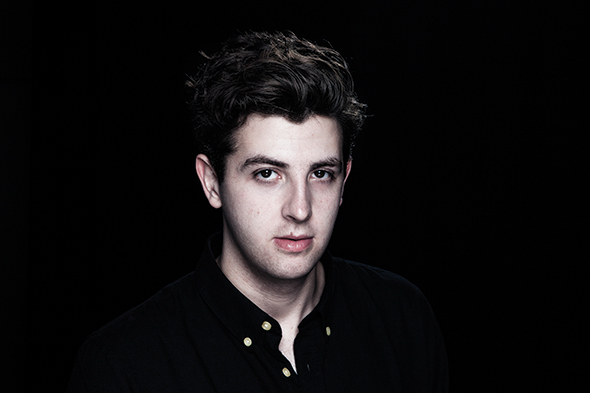Going Solo with In Colour

Jamie xx is notoriously quiet. Not shy or impolite or moody, as people who meet him are quick to clarify, but slightly awkward. The 26-year-old Jamie Smith, who has been given the “Jamie xx” nickname-turned-professional-moniker because of his internationally acclaimed music group, The xx, speaks in a halting, mumbling fashion. Just when you think he’s done making his point, you realize he’s simply stopped talking for a bit and now he’s picking up what he was saying again. Smith’s reclusive disposition is at odds with his job, as a music producer and remix artist, which requires him being thrust into all manner of situations, expected to interact with fans, peers, and executives, and to talk about himself and his music.
In the space of six years Smith has released two albums with The xx. The first was the eponymous winner of the Mercury Prize and its follow-up, Coexist; a reinvention of Gil Scott-Heron’s I’m New Here under the title, We’re New Here. His solo debut, In Colour was released in June. The creation of In Colour, and in its promotion, have been the first time Smith has been entirely on his own. After his time working with Drake, Adele, and Alicia Keys as the electronic music producer/remixer du jour, and dealing with pop world requirements, only having himself to contend with is a welcome relief.
“I’ve always had freedom to do whatever I wanted—other than when working with artists outside my world,” says Smith traveling in a taxi to his home in London on his way back from the airport. “It’s very insular being on your own versus the constant back and forth and compromise with a band. With the band we don’t finish a song until we’re all happy with it. It’s the same with me, except I have nobody to bounce ideas off of.”
In Colour is very much Smith’s vision and his musical voice. Even on the tracks where he features The xx band members, Romy Madley Croft (“Loud Places,” “Seesaw”) and Oliver Sim (“Stranger in a Room”), he collaborates with them individually. “We hadn’t worked one-on-one since before the first album,” says Smith. “It was nice to get back to that idea.”
The concept behind In Colour, came about during a bout of homesickness while Smith was touring Coexist with The xx. Attempting to reconnect with home, coupled with a romanticized idea of going out, he immersed himself in British party culture films like Human Traffic, 24 Hour Party People, and Fiorucci Made Me Hardcore, all of which take place during a time Smith was too young to have experienced firsthand. It was the last of these that inspired, and from which a sample was used, on Smith’s stand-alone single, the softcore “All Under One Roof Raving,” the precursor to In Colour.
“Raving” is too strong of a word to use when describing Smith’s compositions. If anything, In Colour is melancholic. Deceptively minimal, the album summons ghosts of dance floors past, interpreting their vibe and sound with an introverted approach. “It’s kind of what you do every time you go out raving: try and recreate when you had a great time in a club,” says Smith. “It doesn’t always happen.”
Smith’s carefully selected samples, such as the Persuasions on “I Know There’s Gonna Be (Good Times)” featuring Young Thug and Popcaan, clever re-imaginations of melody lines, like Orbital’s “Belfast” on album opener, “Gosh,” and effective reworkings like Freeez’s “I.O.U.” on album closer, “Girl,” give In Colour’s downbeat, nocturnal nature a personal feel.
“Every song on the album has its own color, which represents the color in my head,” says Smith, now in the comfort of his home. “It’s not like synesthesia, just conjuring up a certain color based on the music. I do it with other people’s songs as well, but I don’t think about it as much as I do with my own.”
Much like In Colour’s color spectrum cover art, designed by Smith, his DJ tour for the album connects the tracks he’s playing with assigned colors. He says, “The DJ set is different every time, but I plan the show so when I’m mixing in one of the album tracks or my previous tracks, the whole show goes to that specific look and it becomes obvious as the show progresses that it’s the color to each song.”
An alternate version of Smith’s aural/visual representation, is currently on exhibit in a commissioned piece at the National Gallery in London, until September 6th. Part of the museum’s “Soundscapes” exhibit, Smith created a soundtrack for Théo van Rysselberghe’s 1892 painting, Coastal Scene. Smith says he chose the Belgian neo-impressionist painter’s pointillist work because he was attracted to the dots.
Another avenue for Smith was scoring the Tree of Codes ballet, based on the unusual novel of the same name by Jonathan Safran Foer, and commissioned by the Manchester International Festival. The ballet premiered to rave reviews in Manchester in July and is coming to New York in September.
“I started by taking pages from the book which are sculpted and literally cut out,” says Smith. “They create these patterns that look like melodies. I tried to put those patterns into a computer program to create the melodies that are the basis for the music. It was very abstract which allowed me to work away with my own thoughts without having to be very strict about the music I was making.”
text by Lily Moayeri

